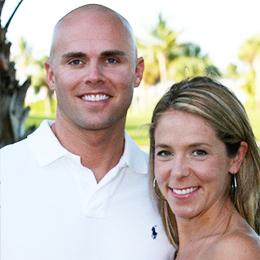
Cardiovascular Medical Technology Saves Alabama Man’s Life
Cardiovascular Disease
Brandon Copia
Everyone’s experienced it: the feeling you get after running very fast. Your heart rate is up, you are short of breath and can feel dizzy or faint. For most people, the feeling goes away after a few moments of rest. But for Brandon Cobia, this was not the case. The Alabama resident and father of two had been living for months with a resting heart rate of 170-180, which is similar to the heart rate of someone who has just completed a 26.2 mile marathon. Within a six-month period, he endured several procedures to correct his condition, called atrial tachycardia, which is a type of arrhythmia known as a supraventricular tachycardia (SVT).
However, only one of the procedures successfully treated the disease, thanks to the utilization of a novel system that uses advanced electromagnetic technology to create real-time 3D maps of a patient’s cardiac structures, essentially the inside of a patient’s heart. The system helps electrophysiologists navigate the heart by generating an accurate 3D map, as well as pinpointing the exact location and orientation of catheters in the heart. Thanks to this innovative technology that makes it easier for doctors to visualize and maneuver through the hearts’ complex chambers, Brandon was finally able to get his heart condition corrected.
Brandon has always led a healthy lifestyle as a runner, non-smoker and health food advocate. He even obtained a Master’s degree in exercise physiology. So when he felt faint and tired during the winter of 2012, he chalked it up to a combination of his high-stress sales job and symptoms of a flu bug. During a regular check-up in May of that year, though, he was told his flu-like symptoms were something much more severe.
SVT is a condition that causes a person’s heart to beat faster than it should for reasons other than exercise, high fever or stress. A normal heart rate in a person at rest is 70 to 80 beats per minute. In a person with SVT, the heart may beat 140 to 250 times per minute. As a result, the heart becomes inefficient and the body may receive an inadequate blood supply. In Brandon’s case, doctors identified a spot in his heart that was “electrically off,” meaning his heart wasn’t functioning to its full capacity. His rapid heartbeat was not allowing enough time for his heart to fill before it started to contract; therefore blood flowing to the rest of his body was compromised. If left untreated, SVT can lead to unconsciousness or cardiac arrest.
Brandon was shocked at the diagnosis. “I’ve been healthy my entire life and did not fit the stereotypical person that suffers from SVT,” he says. “It was frightening; being a husband and father of two young children. I had never had surgery before, and here I was going in for heart surgery.” Brandon endured two surgeries within a three month-time period, but neither procedure worked. “I became increasingly nervous about my situation, and in addition, I was feeling dizzy, short of breath and sick to my stomach.”
Following his second unsuccessful surgery, Brandon was referred to Dr. Jose Osorio, a physician specializing in cardiac electrophysiology in Birmingham, Alabama. “We clicked right away, I finally felt confident that I had the right team in place to fix my SVT,” says Brandon. “Dr. Osorio used enhanced mapping technologies that had not been used in my other surgeries. He saved my life.”
In January 2013, Brandon had his third and final surgery thanks to the 3D mapping system. This medical device helped doctors to easily identify specific cardiac anatomy and pinpointed the exact location of his SVT in real time. “This surgery was different in the sense that we mapped all of the chambers of his heart,” says Dr. Osorio. “Because of this, we were able to pinpoint the specific area of concern and apply controlled levels of radiofrequency energy in what’s called a catheter ablation procedure. His spot was extremely difficult to find, but thanks to this medical device we were able to take care of Brandon.”

Today, Brandon is living a healthy, normal life free of SVT and its debilitating symptoms. In addition to spending as much time with his friends and family as possible, he is in the best shape of his life, including running or exercising almost every day. He also helps his wife, who is an in-home personal trainer, with clients. “The condition is always in the back of my mind, but I’ll never take for granted what I have,” says Brandon. “I am incredibly grateful for this medical device, because it has allowed me to live my life to its fullest.”